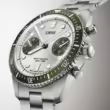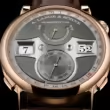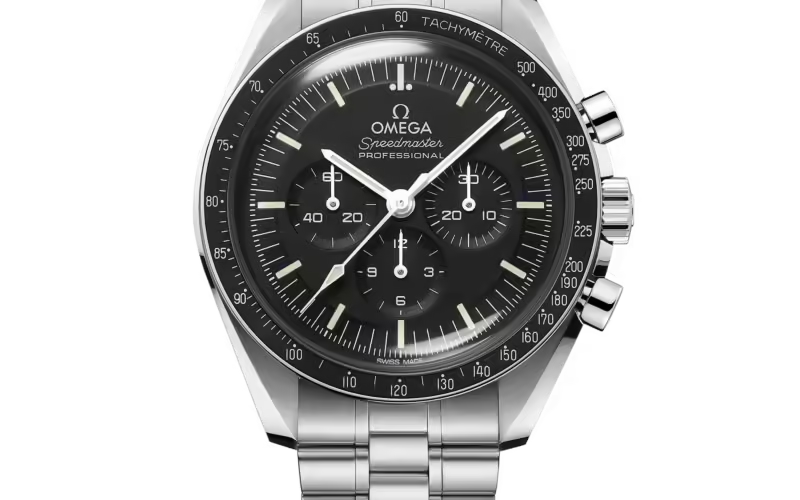The Omega Speedmaster Professional “Moonwatch” is one of the most historically significant watches ever made. First introduced in 1957, it was originally designed as a high-precision chronograph for motorsport timing. When NASA selected it for manned space missions, the Speedmaster became part of every Apollo mission, including the 1969 Moon landing, where it was worn during the first-ever moonwalk.
Decades later, the Speedmaster Moonwatch remains a key reference in Omega’s lineup. Its design has stayed consistent, but Omega has introduced updates to its movement, materials, and construction to improve reliability and durability. The latest version refines these details while keeping the watch’s heritage and practicality intact.
This review takes an in-depth look at the design, movement, wearability, and real-world performance of the Moonwatch to see how it compares to past versions and where it stands among modern chronographs.
The History of the Omega Speedmaster Professional Moonwatch
The Speedmaster debuted in 1957 as a racing chronograph, but its connection to space exploration transformed it into a cultural icon. Omega has made incremental updates over the years, refining the watch while preserving its legendary design.
Key Moments in the Speedmaster’s History
- 1957 – The First Speedmaster (Ref. CK2915)
- Designed for motorsport timing, featuring the signature triple-register chronograph layout.
- Included a steel tachymeter bezel, a first for a chronograph.
- 1962 – First Watch in Space
- Astronaut Wally Schirra wore a Speedmaster (Ref. CK2998) on the Mercury-Atlas 8 mission.
- This led NASA to conduct official testing for an approved space watch.
- 1965 – NASA Certification & Apollo Program
- After rigorous testing, the Speedmaster became the official NASA-issued watch for space missions.
- Ed White wore a Speedmaster during the first American spacewalk (Gemini 4).
- 1969 – The Moon Landing (Ref. ST105.012 & ST145.012)
- Buzz Aldrin’s Speedmaster became the first watch worn on the Moon.
- The Moonwatch earned its legendary status.
- 1998 – X-33 Speedmaster Introduced
- A modernized, digital version developed with astronauts for professional spaceflight.
- A modernized, digital version developed with astronauts for professional spaceflight.
- 2021 – Master Chronometer Update
- Omega upgraded the Moonwatch movement to the Co-Axial Master Chronometer Caliber 3861, improving precision, power reserve, and anti-magnetism.
- Omega upgraded the Moonwatch movement to the Co-Axial Master Chronometer Caliber 3861, improving precision, power reserve, and anti-magnetism.
- 2025 – Latest Iteration
- Further refinements in case finishing, bracelet comfort, and movement performance.
The Speedmaster Professional remains one of the longest-running production watches in history, proving that great design never goes out of style.
Design and Aesthetics: The Ultimate Tool Chronograph
Classic 42mm Case with Asymmetrical Lugs
The 42mm stainless steel case has become a defining feature of the Speedmaster Moonwatch, with its slightly asymmetrical shape designed for better crown and pusher protection.
- Brushed and polished surfaces, enhancing both durability and elegance.
- Hesalite or sapphire crystal options, catering to both purists and modern enthusiasts.
- Tachymeter bezel with “Dot Over 90” (DON) detail, staying true to vintage models.
Though it maintains a tool-watch feel, the Speedmaster wears well on various wrist sizes, thanks to its tapered lugs and balanced proportions.
Dial: Legible, Functional, Timeless
The Speedmaster’s dial is designed for maximum readability, featuring:
- A matte black surface, reducing reflections for better contrast.
- White painted hour markers and hands, providing excellent visibility.
- Three sub-dials for continuous seconds, 30-minute, and 12-hour counters.
The chronograph layout remains uncluttered and intuitive, making it one of the most user-friendly designs in watchmaking.
Bracelet & Strap Options
Omega offers the Moonwatch on both a stainless steel bracelet and a variety of strap options:
- Brushed stainless steel bracelet, redesigned for a more comfortable fit.
- NATO and Velcro straps, inspired by the ones worn by NASA astronauts.
- Leather and rubber straps, offering a more casual or modern feel.
The bracelet now features a micro-adjustment system, improving wearability.
Movement and Performance: The Co-Axial Master Chronometer Caliber 3861
One of the most significant updates to the Speedmaster Moonwatch is the introduction of the Caliber 3861, replacing the previous Caliber 1861.
Key Features of the 3861 Movement:
- Master Chronometer-certified, ensuring accuracy within 0/+5 seconds per day.
- Co-Axial escapement, reducing friction and improving longevity.
- Anti-magnetic up to 15,000 gauss, making it one of the most resistant mechanical movements.
- 50-hour power reserve, offering solid performance for daily wear.
This movement represents one of the most significant technical improvements in the Speedmaster’s history, bringing modern precision to a historically significant watch.
Functionality and Everyday Usability
Built for Real-World Use
Despite its heritage as a space exploration tool, the Speedmaster remains highly functional for everyday use.
- Chronograph function for timing events.
- 100m water resistance, offering protection against splashes and rain.
- Scratch-resistant sapphire crystal option, ideal for daily wear.
Wearability: A Comfortable Sports Chronograph
The Speedmaster sits slightly high on the wrist, but its curved lugs and well-balanced weight distribution make it comfortable. The updated bracelet design improves the fit, making it more ergonomic than previous models.
Omega Speedmaster Professional “Moonwatch” Comparison with Other Chronographs
| Model | Case Size | Movement | Power Reserve | Water Resistance | Price Range |
| Omega Speedmaster Moonwatch | 42mm | Caliber 3861 | 50 hours | 100m | $7,000+ |
| Rolex Daytona 126500LN | 40mm | Caliber 4131 | 72 hours | 100m | $15,000+ |
| TAG Heuer Carrera Chronograph | 42mm | Caliber Heuer 02 | 80 hours | 100m | $5,500+ |
The Speedmaster holds its own against modern chronographs, offering historical significance, strong movement technology, and everyday versatility.
Conclusion: Is the Omega Speedmaster Moonwatch Still the Ultimate Chronograph?
The Omega Speedmaster Professional “Moonwatch” remains one of the most historically significant and technically refined chronographs in watchmaking. While it has been updated with modern movement technology and subtle refinements, it still retains the core design and functionality that made it NASA’s choice for space missions.
It offers:
- A timeless design that has remained largely unchanged since the 1960s.
- A robust, manually wound chronograph movement with Master Chronometer certification.
- A unique connection to space exploration, making it one of the most legendary tool watches ever made.
- Strong value retention, especially for limited editions and vintage references.
For those seeking a chronograph with real history, reliability, and versatility, the Speedmaster Moonwatch remains one of the best choices on the market. It competes with watches like the Rolex Daytona and TAG Heuer Carrera, but its space heritage and timeless appeal set it apart.
FAQ
1. How much does the Omega Speedmaster Moonwatch cost?
Prices for the Speedmaster Moonwatch start at around $7,000 for the Hesalite crystal version and increase for sapphire crystal and special editions.
2. Is the Omega Speedmaster Moonwatch a good investment?
The Speedmaster generally holds its value well, especially vintage models and limited editions. While it doesn’t appreciate as quickly as Rolex models, it remains a respected collector’s piece.
3. Can the Speedmaster Moonwatch be worn daily?
Yes! The 42mm case is comfortable, and the watch pairs well with both formal and casual outfits. The new movement makes it more reliable for everyday use.
4. How does the Speedmaster compare to the Rolex Daytona?
The Daytona is more compact and has a self-winding chronograph, while the Speedmaster retains its manual-wind heritage and historical significance. The Speedmaster is more accessible in price, while the Daytona is harder to obtain at retail.
5. Does the Speedmaster Moonwatch still go to space?
Yes! The Speedmaster remains flight-qualified by NASA and is still used on space missions today.




